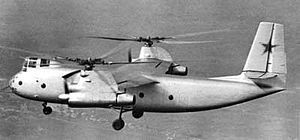Kamov Ka-22 Vintokryl
| Ka-22 | |
|---|---|
 |
|
| Role | Transport Gyrodyne |
| National origin | Soviet Union |
| Manufacturer | Kamov |
| Designer | Vladimir Barshevsky |
| First flight | 15 August 1959 |
| Retired | 12 August 1964 |
| Number built | 4 |
The Kamov Ka-22 Vintokryl (rotor-wing, or literally, (air)screw-wing) (Cyrillic:Камов Ка-22 Винтокрыл) (NATO reporting name: Hoop) was a rotorcraft developed by Kamov for the Soviet Air Force. The experimental transport aircraft combined the capabilities of a helicopter for vertical take-off and landing with those of a fixed-wing aircraft for cruise. The Ka-22 carried a large payload, having a hold comparable in size to the Antonov An-12. Eight world records for altitude and speed were set by the Ka-22 in its class, none of which have since been broken.
In order to increase the effective range of a helicopter, Kamov designer Vladimir Barshevsky drew up a design for a helicopter with wings and an aeroplane propulsive system. In 1954 a proposal was agreed to produce three Ka-22s. The programme was delayed and on 28 March 1956 prototypes 2 and 3 were cancelled. The Ka-22 first lifted from the ground on 17 June 1959, and made its first untethered flight on 15 August 1959. Serious control difficulties were encountered, leading to orders being postponed until the problems were solved, and in July 1960 an order was received to manufacture three more Ka-22s.
The Ka-22 was in essence a fixed-wing aircraft with rotors fitted above the wing tips. An engine was mounted on each wing tip, with drive to both a four-bladed tractor propeller and a four-bladed main rotor. The original prototype was powered by 5,900shp Kuznetsov TV-2VK engines, although these were later replaced by the 5,500shp Soloviev D-25VK. The fuselage contained three-seat cockpit above the glazed nose and a main cargo area large enough to contain 80 seats or 16.5 tonnes of cargo. The entire nose could swing open to starboard for loading bulky items. In helicopter mode, the propeller drive was disconnected, and the flaps were lowered to 90 degrees. In fixed-wing mode, the lifting rotors were free to windmill, and the aircraft was controlled by the ailerons and tail surfaces. The twin-wheel landing gear was fixed.
During its short operational history, a total of eight world records were set by the Ka-22, piloted by D.K. Yefremov and V.V. Gromov. On 7 October 1961, with spats over the wheels and a fairing behind the cockpit, a class speed record was set at 356.3 km/h. The spats and fairing were then removed and on 24 November 1961 a payload of 16,485 kg was lifted to 2,557 m.
...
Wikipedia
